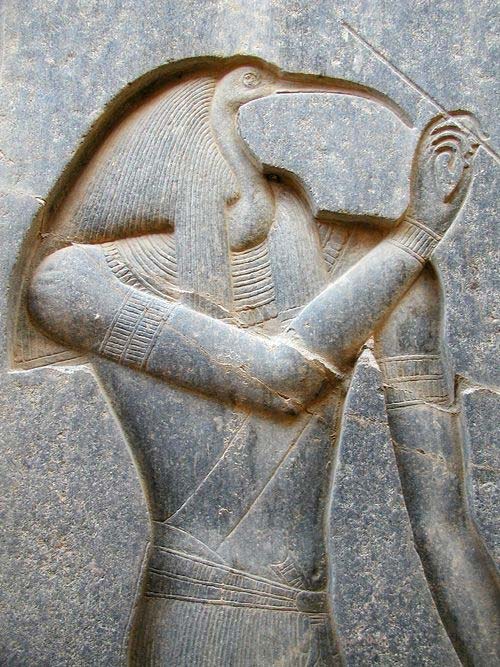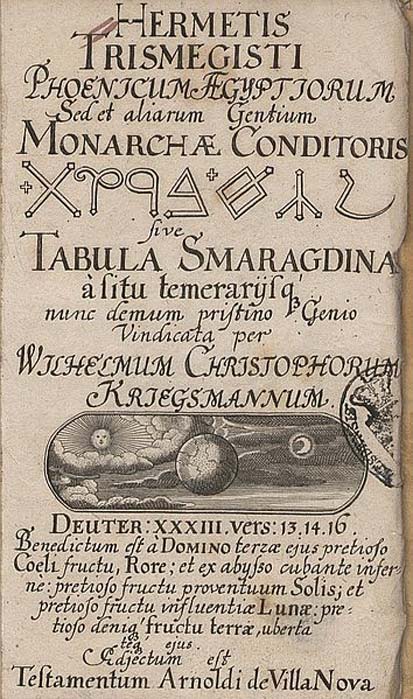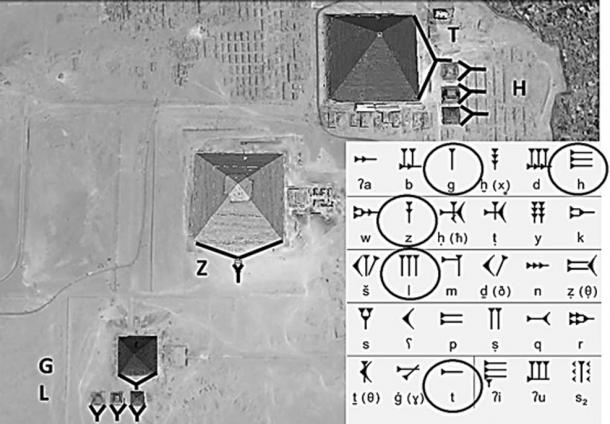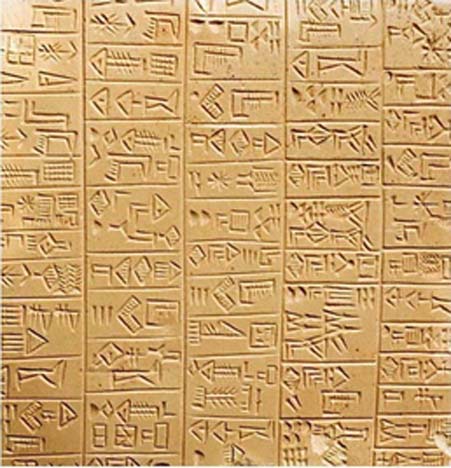
Who Really Built the Pyramids of Giza? Thoth’s Enigmatic Emerald Tablets May Provide the Answer
The Emerald Tablets are one of the greatest enigmas of archaeology. They can be considered an obscure side of Egyptian mythology, characterized by events where myth seems to meet history.
Scholars consider the Emerald Tablets a legend concerning the gods of Ancient Egypt, revealing mysteries involving the ancient societies that survived the Great Flood. The tablets are known as a cryptic Hermetic inscription said to contain the secrets of alchemy and the foundation of the Hermetic tradition.

An imaginative 17th century depiction of the Emerald Tablet from the work of Heinrich Khunrath, 1606. (Public Domain)
The Mythical Origins of the Tablets
According to the myth, Thoth - the Gods' scribe - compiled the tablets. He divided his knowledge into 42 plates of emerald, codifying the great scientific principles ruling the Universe. The legend tells that after the gods’ fall, the Hermetic tablets were cleverly hidden so that no human being might find them. Only Thoth, on his return to that dimension, was able to recover the mysterious book.

A figure of Thoth carved on the back of the throne of the seated statue of Rameses II. (Jon Bodsworth/Public Domain)
According to other interpretations, the tablets were kept in the so-called Hall of Records and then later hidden within the Library of Alexandria until they were lost forever, after the terrible fire which destroyed the ancient building and its legendary books.

A 17th-century edition of the Emerald Tablets, as created in legend by ‘Hermes Trismegistus’—a combination of the Greek god Hermes and the Egyptian god Thoth. (Public Domain)
A very interesting legend told by Jewish mystics connects Thoth’s Tablets to Abraham’s wife, Sarah. According to the myth, she found the Egyptian God’s tomb and his precious manuscripts during their escape into Egypt, fleeing a starvation afflicting Canaan.
In that case, if the narrative is historically accurate, we can assume that the Emerald Tablets’ origins may refer to an ancient time, substantially before the Bible’s Great Flood. Therefore, the origins of the Egyptian gods and the Zep Tepi (a Golden Era or time where gods ruled in Ancient Egypt) may have an intriguing connection, confirmed by other civilizations’ legends.
It was only during the Middle Ages that the Hermetic documents were translated into Latin from Arabic, while the first European printed version was published in Nuremberg, in early 1541. The title was “De Alchimia” written by alchemist Johannes Baptista Montanus Veronensis Patricius. Thanks to his work, the ancient documents have survived until now.
Fact or Fiction?
Analyzing the legendary texts, questions surface: can we assume that the Hermetic document is a real historical fact and not a myth? What should we make of the contents and scientific codes inscribed into the tablets? Is there a possible connection between the god Thoth and the Pyramids Civilization?
According to the mysterious document, can we state that Thoth was the builder of Giza?
In my two decades of experience, I learned to trust in objective facts, as a result of a precise model of investigation. Starting from a study of the myths, I aim to propose a new point of view concerning the possibility that the myth of Thoth is a true story.
“Built I the Great Pyramid, patterned after the pyramid of earth force, burning eternally so that it, too, might remain through the ages. In it, my knowledge of ‘Magic-Science' so that it might be here when again I return from Amenti. Aye, while I sleep in the Halls of Amenti, my soul roaming free will incarnate, dwell among men in this form or another.” – Emerald Tablet 1
Emerald Tablet I – The History of Thoth
If the Emerald Tablets are reliable, what might the relationship between Thoth and the Great Pyramid look like?

Djehuty (Thoth) in the Luxor Temple by night. (CC BY-NC 2.0)
The first line, “ Built I the Great Pyramid”, is a clear expression concerning an unambiguous assignment of the project ownership. Have findings confirmed this possibility, least of all for the Great Pyramid, within which no inscription referring to the builders was ever found?
The only exception are some symbols found on the back of the Gantenbrink’s door—a limestone door with two eroded copper handles found in shafts in the Great Pyramid’s Queen’s Chamber, discovered by German engineer Rudolf Gantenbrink. In my opinion, and by analyzing the signs, I can assume that the marks cannot be assigned to a well-known Ancient Egyptian writing, although Egyptologist Luca Miatello related the obscure handwriting to Hieratic, and its meaning to a sequence of numbers and measurements by which to build the conduits into the Queen’s Chamber. I consider his theory unfounded because of the lack of correlation among clues and hieratic writing. It could be a kind of unknown writing, increasing the mystery on the origins of the Giza Pyramids.

Markings on Gantenbrink’s door. (via author)
In 2013, I achieved a very interesting result, which might prove a possible relationship between the Hermetic Emerald Tablets and the Giza Plateau. Something happened quite by chance during my archaeological campaign at the Sphinx and its temples.

Map of the Giza Plateau (via author)
During a moment of peace, in the shadow of the Valley Temple, I observed a Giza map taken from above, thinking that each pyramid looked like a microcosm, as the satellite pyramids, fences, temples and other constructions characterize each one. Considering the pyramids altogether, I perceived an order of factors making them an independent form of architectural expression.
In fact, pyramids, seen from above, look like three very large stylus-wedges embedded in the ground. Their very special shape enlightened me, suggesting an intriguing hypothesis. Just out of curiosity, I traced some guidelines starting from the corners of the major pyramids, toward the center of the monuments, following the satellite pyramids’ orientation. Then I drew the same lines for the satellite pyramids, according to their cardinal direction.
Therefore, I obtained the following image.

Pyramids look like enormous wedges. (Image via author)
Ancient Scripts Tell a Tale
It is curious to observe how a very easy geometric exercise might instill a deep doubt, challenging the foundation of humankind’s history and the origins of modern societies. In fact, to detect the possible existence of cuneiform writing in the land of hieroglyphics can be considered a crazy idea. As presently known, academic considerations about Sumerian and Egyptian civilizations story are very precise; in fact, they assume that during their time the two cultures had never been in contact.
With this in mind, I should have given up my curiosity; however, I wanted to listen to my own instincts because I found the possible connection between pyramids and cuneiform writing very compelling.

Cuneiform alphabet and their geometric forms, and possible relationship with the Pyramids of Giza. (Image via author)
A comparison between the pyramids’ geometric forms and cuneiform writing is possible by analyzing the Sumerian alphabet, containing the symbols of each letter.
Sometimes, you begin the game for fun, but during the conduct of the pastime, you feel that something is changing, a realization is coming, and you are enchanted. I felt those same emotions, analyzing results of my ‘game’ that over time revealed themselves.
The possible coincidence slowly became something different, perhaps a detailed concept. Despite the fact that I was confident that scholars’ theories were well anchored, in my core something pushed me to improve a hypothesis never examined before. Observing the following image, it is astonishing to note the unbelievable correlation between some Sumerian letters and the signs I obtained while drawing the lines at the pyramids base.
For example, Mycerinus Pyramid (Pyramid of Menkaure, the smallest of the three main Giza Pyramids and at the bottom of the map) – with a triangle projection towards its satellite pyramids – has a geometrical form very similar to the cuneiform letter for “G”; i.e. a wedge downward. Equally, I can state that Mycerinus’ satellite pyramids look like the cuneiform letter for “L”, having three wedges downward.

The relationship between tridimensional wedges of the pyramids and cuneiform letters from the Sumerian alphabet. (Image via author)
I followed the same procedure for all pyramids of Giza. Khafre’s Pyramid, for example, (the second-largest of the Ancient Egyptian Pyramids, and in the middle of the map) has a little peculiarity, because of the position of its satellite pyramid, very close to the major monument. It is a very unusual architectural technique, compared to the other pyramidal complexes, showing the precise builders’ will to meld the monuments into having a single and homogeneous design. As result of this, the graphic sign is very similar to the Sumerian letter for “Z”.
Finally, the Great Pyramid (the largest of the plateau and at the top of the map) and its satellites give very exciting symbols, perfectly connected to cuneiform letters, i.e. to the letter “T” as a cuneiform towards the right side, and to the letter “H”, characterized by three cuneiform symbols towards right side.
Therefore, I obtained the following sequence:
GL – Z- TH
Originally, cuneiform writing was inscribed vertically, and in the event of more lines, they were aligned from right to left. It is interesting to note that pyramid position on the Giza Plateau develops in accordance with a vertical orientation – from the highest place, i.e. the Great Pyramid, until the lowest, i.e. the Mycerinus Pyramid – and in different lines. Moreover, as the Sumerian writing was characterized for a lack of vowels, so is for the geometrical symbols obtained by the pyramids.

Letters sequenced from West to East, observing the pyramids from South. (Map via author)
So far, we have observed some technical characteristics of the Sumerian writing and its homogeneity with symbols coming from graphics processing of the Giza buildings. Now, let us look to the complete sentence, with vowels, searching for a possible meaning of the ancient message:
GaL Zu TeHu

Finding meaning in the message. (Image via author)
The meaning of the message is: TeHu the Great Wise
It is very clear that the word TeHu refers to a proper noun, very probably to the designer of the Giza Project.
To unveil the name, I studied the Egyptian Book of Dead (as translated by Wallis Bydge and also Boris de Rachewiltz) where the name of TeHu refers to Thoth. In fact, one of the Egyptian words indicating the Ibis is Tekh, which sounds like the name TeHu; that word refers to the Moon as Measurer of the Time, and that is why Egyptians depict Thoth as Ibis.

Thoth is often depicted as an Ibis. Egypt, Late Period, 712-332 B.C. (Public Domain)
Language of the Ancient Gods
The analysis is very fascinating, but proposes a series of questions:
1) The message indicates that Thoth was the designer of Giza, as reported in the Emerald Tablets. Does it mean that the Book of Thoth really exists?
2) If the Sumerian correlation with the monuments has a scientific validity, the question is why, in the distant past of Egypt, did the population use the Sumerian writing?
When one studies the origins of cuneiform writing, we find that archaeologists date it to 3500 BC. Nevertheless, it’s very interesting that when the writing appeared it was characterized by an extraordinary complexity, consisting of over a thousand phonetic symbols. Over time, the writing had a rationalization process and it reduced to hundreds of symbols. So, we can suppose that Sumerian writing was born in a very full form, and experienced a process apart from all other writing forms which display real signs of evolution. Only cuneiform is considerably convoluted – or, as archaeologists suggest, “rationalized” – as if it followed its founders’ decline.
Can we argue that the Sumerian was the language used by the ancient Gods? Can we state that Middle Eastern and Egyptian cultures, during the pre-dynastic age, were influenced by an ancient and unknown Civilization?

Sumerian inscription in monumental archaic style, c. 26th century BC (Public Domain)
According to historians, due its geography, Egypt was isolated from the outside world until the First Intermediate Period, around 2000 BC—without experiencing any kind of influence from other civilizations. Therefore, the possible ‘corruption’ could have happened a long time before the pre-dynastic age. Furthermore, one of the most interesting pieces of evidence could be the numbers of Egyptians gods that are very similar to the Sumerians ones. Indeed, the story of the Sumerian Gods is very similar to the Egyptian Neteru, and the great part of religious traditions of eastern civilizations.
An unknown civilization seems to have bequeathed symbols we can find everywhere around the planet; for example, the winged sun, or caduceus, even the gods who have different names but similar functions. It is possible that this civilization could have inspired the Sumerian and Egyptian cultures, uncontacted, and likewise shared many symbols and divinities. It is undeniable that the two cultures originated from a “matrix” which lived in the distant past.
If Egyptian and Sumerian civilizations have deep cultural and religious correlations, it may mean they were generated by a lost civilization, maybe the same who built pyramids all around the planet.
The Legendary Emerald Tablets
Lastly, did the Emerald Tablets really exist? Maybe we will never have a confirmation, but it is thrilling to show the relationship between the god Thoth and the Giza Plateau, as the result of an easy geometrical game, which gave an unexpected answer to one of the most fascinating mysteries of the past. It is also interesting to suppose that the Sumerian writing system offered a Hermetic link with the Ancient Egyptians, which was historically never detected, but clear in my proposal.
All these indications can be considered very important clues and may be regarded as the starting point to understanding the scientific meaning of the pyramids and the Knowledge of which they are keeper.
(Top image: The Giza Pyramids - CC BY-NC-SA 2.0, and Egyptian god Thoth – CC0)
By Armando Mei
References
Armando Mei (2014) ‘Il Segreto Degli Dei’.[Italian] CreateSpace Independent Publishing Platform; I edizione (11 dicembre 2014)
















Comments
I remember on I think it was Nat Geo about 15 years ago they did a satelite image of that region and there were a ton of buried structures surrounding the Pyramids. Did you take those into account as well as the Sphinx? Also, I wonder if the Cental American structures have a similar clue (remember the bowl from South America with Cuniform on it)
If the aerial photos of the pyramids reveal the name of the builder in a hidden code based upon the Sumerian writing system, then the message is “ZL-G-TH” and not “GL-Z-TH”. It still has Thoth as the opening, but the title is different. So what is the title?
Grant Steffy Sr.
Do Thoth's Emerald Tablets exist today in English or do I have to buy The Hermatic link to the Emerald Tablets?
Mary Madeline